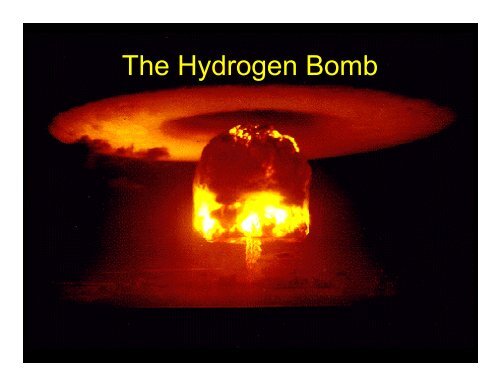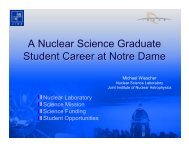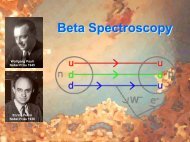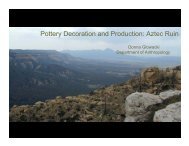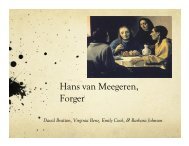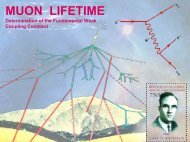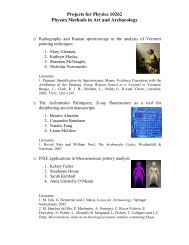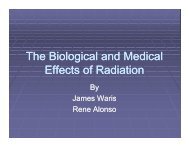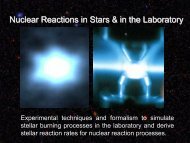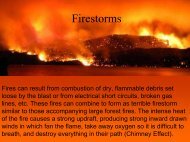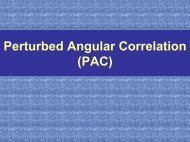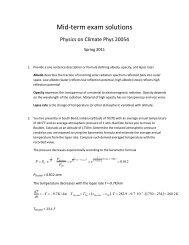Create successful ePaper yourself
Turn your PDF publications into a flip-book with our unique Google optimized e-Paper software.
<strong>The</strong> <strong>Hydrogen</strong> <strong>Bomb</strong>
Questions 7<br />
1. Why are countries, who seek to install a nuclear<br />
weapon program interested in building a<br />
deuterium enrichment program?<br />
2. What are the two important aspects the 6 Li(n,t) 4 He<br />
reaction has for the fusion weapon industry?<br />
3. Why does a fusion bomb need a fission trigger?
<strong>The</strong> fusion process<br />
2<br />
H+ 3 H ⇒ 4 He+n+Q ≡ 17.6 MeV<br />
Energy release Q=17.6 MeV<br />
In comparison<br />
2<br />
H+ 2 H ⇒ 1 H+ 3 H +Q ≡ 4.0 MeV<br />
2<br />
H+ 2 H ⇒ 3 He+n +Q ≡ 3.2 MeV<br />
3<br />
H+ 3 H ⇒ 4 He+2n+Q ≡ 11.3 MeV<br />
235<br />
U+n ⇒ X A +X B +3n +Q ≈ 200 MeV<br />
Fusionable Material, deuterium 2 H (D) and tritium 3 H (t):<br />
Deuterium: natural occurrence (heavy water) (0.015%).<br />
Tritium: natural occurrence in atmosphere through cosmic ray<br />
bombardment; radioactive with T 1/2 =12.3 y.
Cross sections
“Advantages” of hydrogen bomb<br />
Fusion of 2 H+ 3 H:<br />
Fission of 235 U:<br />
Q 17.6 MeV<br />
=<br />
A 2<br />
Q<br />
A<br />
=<br />
=<br />
3.5<br />
MeV<br />
( 3+ + 2<br />
) amu<br />
amu<br />
200 MeV<br />
236 amu<br />
=<br />
0.85<br />
Fusion is 4 times more powerful than fission<br />
and generates 24 times more neutrons!<br />
Neutron production:<br />
2<br />
H<br />
+<br />
235<br />
U<br />
3<br />
H<br />
+<br />
:<br />
n<br />
A<br />
=<br />
1<br />
5<br />
=<br />
0.2<br />
n 2<br />
n<br />
: =<br />
A 236<br />
=<br />
MeV<br />
amu<br />
0.00850085
Fuel Considerations<br />
Successful operation of hydrogen bomb requires<br />
light fusionable fuel.<br />
deuterium for d+d based bombs<br />
tritium & deuterium for d+t based bombs<br />
tritium needs to be replaced regularly<br />
on-line produced tritium through 6 Li(n,t)<br />
Natural production of tritium by cosmic ray induced neutron<br />
reactions 14 N(n,t) 12 C with atmospheric nitrogen yields a natural<br />
abundance of 0.0000000000000003% (deuterium 0.015%).<br />
Industrial production facilities are necessary.
Deuterium Fuel Production<br />
Deuterium separation takes place by electrolysis or chemical<br />
catalysts based methods with subsequent distillation.<br />
Electrolysis separates water in oxygen and hydrogen. <strong>The</strong> hydrogen<br />
and deuterium mix can then be liquefied and distilled to separate the<br />
two species.<br />
Chemistry based methods include distillation of liquid hydrogen and<br />
various chemical exchange processes which exploit the differing<br />
affinities of deuterium and hydrogen for various compounds. <strong>The</strong>se<br />
include the ammonia-hydrogen system, which uses potassium amide<br />
as the catalyst, and the hydrogen sulfide-water system (Girdler<br />
Sulfide process). Process enriches to ~15% deuterium.<br />
Distillation process of deuterium enriched water leads to 99%<br />
enrichment – boiling points of heavy water (101.4 °C) and normal<br />
water (100 °C).<br />
Known producers are Argentina, Canada, India, Norway, plus all five<br />
declared Nuclear Powers. Recent newcomers are Pakistan and Iran.
Heavy Water Plants<br />
Newly-Identified<br />
Heavy Water Plant<br />
Khushab, Pakistan<br />
<strong>The</strong> estimated production<br />
capacity is 50-100 tons<br />
of fheavy water per year.<br />
Kota, India
How about the latest newcomer?<br />
A general view of a heavy water plant in Arak,<br />
Iran320 km south of Tehran in 2004 & 2006.<br />
<strong>The</strong> now completed heavy water plant is<br />
located next to the construction site of the Arak<br />
40 MW heavy water reactor which h is potentially<br />
ti capable of breeding plutonium for a weapons<br />
program.
Tritium fuel production<br />
Tritium occurs naturally but low abundance can be enhanced by accelerator<br />
or reactor based tritium breeding through neutron capture on 6 Li(n,t) 4 He.<br />
<strong>The</strong> United States has not produced tritium since 1988, when the Department of<br />
Energy closed it’s production facility site in South Carolina. Immediate tritium needs<br />
are being met by recycling tritium from dismantled U.S. nuclear weapons. New plans?
Maintaining weapon stock-pile<br />
N<br />
1<br />
Loss of tritium fuel<br />
0.9<br />
in nuclear warheads<br />
08 0.8<br />
3<br />
H(β - ν) 3 He<br />
0.7<br />
by natural decay<br />
0.6<br />
~5% per year!<br />
0.5<br />
0.4<br />
ln 2 0.3<br />
(<br />
t<br />
t<br />
0.2<br />
t<br />
)<br />
− ⋅<br />
1/ 2<br />
= N<br />
(<br />
t<br />
)<br />
3 3 ⋅e<br />
H<br />
H<br />
0 01 0.1<br />
0 10 20 30<br />
tritium<br />
filling (%)<br />
time (y)<br />
To keep nuclear weapons stockpiles at the level prescribed by the<br />
START I (Strategic Arms Reduction Treaty), however, the United States<br />
will require a tritium supply capable of producing three kilograms of<br />
tritium each year, to go online no later than 2007. Breaking the taboo of<br />
using civilian nuclear reactors to supply nuclear weapons materials, the<br />
U.S. Nuclear Regulatory Commission (NRC) approved licenses in 2009<br />
to allow tritium production at two Tennessee nuclear power plants.
New US tritium production plans<br />
On May 22, 1996, DOE and NRC agreed<br />
on the use of commercial reactors for the<br />
production of tritium. Lithium containing<br />
control rods instead of boron rods will be<br />
used in pressurized water reactors for<br />
absorbing neutrons. Neutron capture on<br />
lithium in control rods will produce tritium.<br />
<strong>The</strong> rods are later removed from the fuel assemblies for extracting the tritium.<br />
<strong>The</strong> two production reactors<br />
are Watts Bar Nuclear Plant<br />
and Sequoyah Nuclear Plant<br />
in Tennessee.<br />
Non-proliferation<br />
Concerns!
Disadvantages for hydrogen bomb<br />
etrability<br />
Coulo omb Pen<br />
1.0E+00<br />
yPrevents “thermal”<br />
Ignition!<br />
1.0E-03<br />
2<br />
H+ 3 H fusion<br />
1.0E-06<br />
probability<br />
1.0E-09<br />
1.0E-12<br />
High ignition temperature re<br />
required: 50-100 Million K<br />
1.0E-15<br />
0.001001 001 0.01 01 0.1 1 10<br />
Energy<br />
Acceleration of positive charged particles towards<br />
high energies above Coulomb barrier is necessary!
<strong>The</strong> Fathers of (US) <strong>Hydrogen</strong> <strong>Bomb</strong><br />
All thermonuclear weapons existing in the world today appear to be based<br />
on a scheme usually called the "Teller-Ulam" design (after its inventors<br />
Stanislaw Ulam and Edward Teller, two emigrants), or "staged radiation<br />
implosion" for a physically descriptive designation.<br />
Teller, Hungarian physicist,<br />
PhD 1930 Leipzig, Germany<br />
with Heisenberg. Emigration<br />
to the US 1935. He worked<br />
with Oppenheimer in 1943 -<br />
1946 on the Manhattan<br />
project.<br />
Stanislaw Ulan 1943;<br />
Ulam, Polish mathematician,<br />
came 1935 to US (Harvard),<br />
joined Manhattan project in<br />
1943<br />
Edward Teller
Lawrence Livermore Laboratory<br />
Founded in 1952 in San Francisco bay area as second US weapons<br />
National Laboratory for the development and construction of H bomb.<br />
H-bomb development and test program progressed through Livermore.<br />
First director Edward Teller, most controversial figure in nuclear weapons<br />
history, fight with Oppenheimer about H-bomb feasibility, accusing Oppenheimer<br />
disloyalty lt (Oppenheimer lost security clearance in 1954). Pushed weapons testt<br />
program from the early 50s to the 80s, instigated Reagan’s star war program
Ulam-Teller Design<br />
Staged explosion of fission (primary)<br />
bomb and fusion (secondary bomb).<br />
<strong>The</strong> fission bomb is based on a<br />
regular Pu bomb design (Fat Man).<br />
Fusion device is based on d+d & d+t<br />
reaction with on-line 6 Li(n,t) tritium<br />
production and n induced fission.<br />
<strong>The</strong> fusion bomb is triggered by<br />
rapid shock driven compression<br />
(Ulam) which is enhanced by<br />
radiation pressure (Teller) from<br />
released X-ray and γ-ray flux.
Fuel<br />
Primary Fission Device<br />
Core: 239 Pu, 235 U,<br />
plus 2 H+ 3 H booster<br />
Shell: 238 U tamper<br />
High explosive lenses<br />
Secondary Fusion Device<br />
Radiation i channel<br />
239<br />
Pu sparkplug<br />
6 Li, 2 H, 3 Hf fusion cell<br />
238<br />
U tamper
Event Sequence<br />
<strong>The</strong> two devices are surrounded by radiation case to contain<br />
(temporarily) the energy released in primary fission driven<br />
explosion for efficient conversion into compression shock<br />
Additional pressure from recoil of exploding shell (ablation)!
Radiation pressure P rad<br />
F<br />
1<br />
P = = ⋅a<br />
⋅T<br />
4<br />
rad<br />
F: force A<br />
3<br />
A: Area<br />
a: radiation constant: a=7.566·10 -16 J m -3 K -4<br />
T: temperature in K …. For T≈10 7 K<br />
( )<br />
J<br />
P 1 −16<br />
7 4<br />
11 ⎡<br />
−<br />
Pa bar<br />
rad<br />
7.566 10 10 2.52 10<br />
10<br />
5 ⎤<br />
= ⋅ ⋅ ⋅ = ⋅<br />
3<br />
3<br />
⎢<br />
= =<br />
⎣m<br />
⎥<br />
⎦<br />
P rad<br />
= 2.<br />
52<br />
Mbar<br />
[ ]
Pressure Conditions in MIKE<br />
<strong>The</strong> W80 is a modern thermonuclear warhead (fusion weapon) in the enduring<br />
stockpile with an adjustable explosive yield of between 5 and 150 KT TNT.<br />
Comparing the three mechanisms for generating ignition pressure, we see that:<br />
• Radiation pressure:<br />
Ivy Mike: 73 million bar (7.3 TPa)<br />
W-80: 1.4 billion bar (140 TPa)<br />
• Plasma pressure:<br />
Ivy Mike: (est) 350 million bar (35 TPa)<br />
W-80: (est) 7.5 billion bar (750 TPa)<br />
• Ablation pressure:<br />
Ivy Mike: 5.3 billion bar (530 TPa)<br />
W-80: 64 billion bar (6400 TPa)<br />
<strong>The</strong> calculated ablation pressure is one order of magnitude greater than the<br />
higher proposed plasma pressures and nearly two orders of magnitude greater<br />
than calculated radiation pressure. No mechanism to avoid the absorbtion of<br />
energy into the radiation case wall and the secondary tamper has been<br />
suggested, making ablation apparently unavoidable.
• First staged fusion explosion occurred on Eniwetok Atoll on Oct. 31, 1952.<br />
• Mike used liquid deuterium as a fuel.<br />
• <strong>The</strong> output of 10.4 megatons of TNT exceeded all of the explosives used in<br />
WW II including both atomic bombs.<br />
Mike<br />
Mike consisted of a cylinder about 20 ft high, ~7 ft wide, weighing 164,000 lb;<br />
<strong>The</strong> detonation of Mike left underwater crater 6240 feet wide and 164 ft deep.<br />
Mike created a fireball 3 miles wide; the 'mushroom' cloud rose to 57,000 ft in<br />
90 seconds, and topped out in 5 minutes at 135,000 ft , with a stem eight miles<br />
across. <strong>The</strong> cloud eventually spread to 1000 miles wide, with a stem 30 miles<br />
across. 80 million tons of soil were lifted into the air by the blast."
<strong>The</strong> Castle-Bravo Test
Soviet Response 1955<br />
RDS-37: <strong>The</strong> First Soviet Superbomb ("True H-<strong>Bomb</strong>") Test<br />
November 22,1955; Semipalatinsk Test Site, Kazakhstan<br />
<strong>The</strong> RDS-37 bomb exploded<br />
underneath an inversion<br />
layer, which focused the<br />
shock back toward the<br />
ground unexpectedly. This<br />
refracted shock wave did<br />
some unanticipated collateral<br />
damage, killing three people<br />
from a building collapse.
<strong>The</strong> Cold War and Nuclear Arms Race<br />
I remember President Kennedy once stated... that the<br />
United States had the nuclear missile capacity to wipe out<br />
the Soviet Union two times over, while the Soviet Union<br />
had enough atomic weapons to wipe out the Unites States<br />
only once... When journalists asked me to comment... I<br />
responded, "Yes, I know what Kennedy claims, and he's<br />
quite right. But I'm not complaining... i We're satisfied to be<br />
able to finish off the United States first time round. Once is<br />
quite enough. What good does it do to annihilate a country<br />
twice? We're not a bloodthirsty people.“<br />
Nikita Khrushchev - 1974
Ridiculous Dimensions<br />
Biggest US bomb:<br />
1MT TNT MARK-17<br />
Biggest Soviet <strong>Bomb</strong>:<br />
50 MT Tsar <strong>Bomb</strong><br />
<strong>The</strong> big bomb never had any military significance. It was a demonstration of<br />
force, part of the superpower game of mutual intimidation. This was the main<br />
goal of the unprecedented test. Super-weapons are rejected by contemporary<br />
military doctrine, and the proposition that “now we have even more powerful<br />
warheads” is simply ridiculous.
Attempts for stopping the race<br />
<strong>The</strong> Baruch Plan 1946; Bernard Baruch, U.S. representative to the U.N. Atomic<br />
Energy Commission, seemed to propose a radical plan to put atomic weapons<br />
under strict ti tU.N. control. <strong>The</strong> United Statest was at the time the only nuclear power<br />
in the world. Under the so-called Baruch Plan, the United States would relinquish<br />
its atomic monopoly in favor of the creation of a new U.N. Atomic Development<br />
Authority, which would become e the sole body in the world that could legally<br />
possess nuclear arms. Violators were subject to preemptive measures including a<br />
nuclear strike. <strong>The</strong> Soviet Union opposed the Baruch Plan because its refusal to<br />
consider the veto right, and in 1949 the first Soviet atomic bomb was detonated.<br />
UN proposal for nuclear disarmament 1955; Soviet Union accepted the plan, after<br />
achieving hydrogen weapon success. In 1956 US rejected the U.N. proposed plan<br />
for disarmament and identified nuclear weapons as a “powerful deterrent to war”<br />
Voluntary Test Moratorium: 1958-1961<br />
October 10, 1963; Limited Nuclear Test Ban Treaty
Towards a Test Ban treaty?<br />
<strong>The</strong> three nuclear powers refrained from testing beginning 1958. This<br />
voluntary "moratorium" was marked by several public statements of<br />
intent, by the United States, the United Kingdom, and the Soviet Union,<br />
in varying degrees of specificity and with various caveats. At the end of<br />
December 1959 President Eisenhower announced that the United<br />
Statest would no longer consider itself bound by the "voluntary<br />
moratorium" but would give advance notice if it decided to resume<br />
testing. <strong>The</strong> Soviet Government stated on August 28 and Premier<br />
Khrushchev repeated on December 30, 1959, that the Soviet Union<br />
would not resume testing if the Western powers did not. France<br />
conducted its first test on February 13, 1960, two more later in the<br />
year, and a fourth on April<br />
25, 1961. On May 15, 1961, the Soviet<br />
Government stated that if France continued testing, the Soviet Union<br />
might be compelled to test. On August 30, 1961, although neither the<br />
United States nor the United Kingdom had resumed testing and France<br />
had not continued to test, the Soviet Union announced that it would<br />
resume testing. It did so on September 1, thus ending the moratorium.<br />
<strong>The</strong> United States resumed testing two weeks later.
Why?<br />
1960 -- May 2: U-2 INCIDENT A U.S. - U-2 reconnaissance plane is shot<br />
down over Sverdlovsk in the Soviet Union. Premier Khrushchev cancels a<br />
scheduled four-power Paris summit, and no further progress is made in the<br />
testt ban negotiations.<br />
1960 -- February 13: FIRST FRENCH NUCLEAR TEST France explodes<br />
its first nuclear device at a test site in the Sahara Desert.<br />
1961 -- September 1: RESUMPTION OF SOVIET NUCLEAR TESTING -<br />
Arguing that increased international tensions and the French nuclear test<br />
program have created a changed security environment, the Soviet Union<br />
resumes atmospheric nuclear testing.


